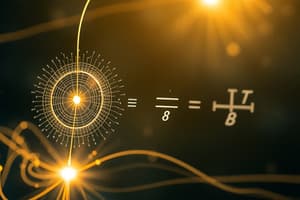Podcast
Questions and Answers
What does Gauss's Law for Electricity indicate about electric charges?
What does Gauss's Law for Electricity indicate about electric charges?
- Electric charges create magnetic fields.
- Electric charges produce electric fields. (correct)
- Electric fields are always constant in closed surfaces.
- Electric fields can exist without charges.
What does the Ampère-Maxwell Law imply about magnetic fields?
What does the Ampère-Maxwell Law imply about magnetic fields?
- They can exist independently of electric fields.
- They can never change over time.
- They are caused only by the presence of magnetic monopoles.
- They are produced by electric currents and changing electric fields. (correct)
What is the mathematical representation of Faraday's Law of Induction?
What is the mathematical representation of Faraday's Law of Induction?
- ∮ B · dA = μ₀(I_enc + ε₀ dΦ_E/dt)
- ∮ E · dl = -dΦ_B/dt (correct)
- ∮ E · dA = Q_enc / ε₀
- ∮ B · dA = 0
Which of the following statements is true regarding Gauss's Law for Magnetism?
Which of the following statements is true regarding Gauss's Law for Magnetism?
What do Maxwell's Equations predict about electromagnetic waves?
What do Maxwell's Equations predict about electromagnetic waves?
Flashcards are hidden until you start studying
Study Notes
Maxwell's Equations
- Overview: Maxwell's Equations are a set of four fundamental equations that describe how electric and magnetic fields interact and propagate.
-
Gauss's Law for Electricity
- States that the electric flux through a closed surface is proportional to the enclosed electric charge.
- Mathematically: ∮ E · dA = Q_enc / ε₀
- Implications: Electric charges produce electric fields.
-
Gauss's Law for Magnetism
- Indicates that there are no magnetic monopoles; magnetic field lines are always closed loops.
- Mathematically: ∮ B · dA = 0
- Implications: The net magnetic flux through any closed surface is zero.
-
Faraday's Law of Induction
- Describes how a changing magnetic field creates an electric field.
- Mathematically: ∮ E · dl = -dΦ_B/dt
- Implications: A time-varying magnetic field induces an electromotive force (emf).
-
Ampère-Maxwell Law
- Relates magnetic fields to the electric current and the change in electric field over time.
- Mathematically: ∮ B · dl = μ₀(I_enc + ε₀ dΦ_E/dt)
- Implications: Electric currents and changing electric fields produce magnetic fields.
Key Concepts
-
Field Quantities:
- E: Electric field vector (measured in volts per meter, V/m).
- B: Magnetic field vector (measured in teslas, T).
-
Constants:
- ε₀: Permittivity of free space.
- μ₀: Permeability of free space.
-
Electromagnetic Waves:
- Solutions to Maxwell's Equations predict the existence of electromagnetic waves, which travel at the speed of light (c = 1/√(ε₀μ₀)).
-
Applications:
- Electromagnetic theory is foundational in technologies such as radio, television, radar, and wireless communications.
Conclusion
Maxwell's Equations unify electricity and magnetism into a single theory, forming the basis for classical electromagnetism and impacting many scientific and engineering fields.
Overview of Maxwell's Equations
- Maxwell's Equations consist of four key equations governing electricity and magnetism interactions and their propagation.
Gauss's Law for Electricity
- The electric flux through a closed surface is proportional to the enclosed electric charge.
- Mathematically represented as: ∮ E · dA = Q_enc / ε₀.
- Highlights that electric charges generate electric fields.
Gauss's Law for Magnetism
- States that magnetic monopoles do not exist; magnetic field lines form closed loops.
- Represented mathematically as: ∮ B · dA = 0.
- Signifies that the net magnetic flux through any closed surface is always zero.
Faraday's Law of Induction
- A changing magnetic field induces an electric field.
- Mathematical expression: ∮ E · dl = -dΦ_B/dt.
- Indicates that a time-varying magnetic field results in an electromotive force (emf).
Ampère-Maxwell Law
- Connects magnetic fields to electric currents and the rate of change of electric fields.
- Mathematically represented as: ∮ B · dl = μ₀(I_enc + ε₀ dΦ_E/dt).
- Demonstrates that both electric currents and changing electric fields generate magnetic fields.
Key Concepts
-
Field Quantities:
- E: Electric field vector measured in volts per meter (V/m).
- B: Magnetic field vector measured in teslas (T).
-
Constants:
- ε₀: Permittivity of free space, a constant defining electric field properties.
- μ₀: Permeability of free space, a constant defining magnetic field properties.
-
Electromagnetic Waves:
- Maxwell's Equations predict electromagnetic waves, which travel at the speed of light: c = 1/√(ε₀μ₀).
-
Applications:
- Underpin technologies such as radio, television, radar, and wireless communications, showcasing the practical importance of electromagnetic theory.
Conclusion
- Maxwell's Equations unify electricity and magnetism, forming the backbone of classical electromagnetism and influencing various scientific and engineering disciplines.
Studying That Suits You
Use AI to generate personalized quizzes and flashcards to suit your learning preferences.




